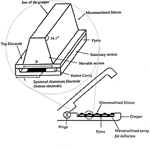

In this issue...
Task Analysis
|
The Newsletter of the |
Laparoscopy refers to visual inspection and surgery within the abdominal cavity with endoscopic tools. It means shorter recovery time, less infection risk, less pain and trauma for the patient, and reduced hospital costs. This rapidly growing field relies on video feedback and relatively primitive surgical instruments inserted through small incisions. The AMD-3 group is developing advanced endoscopic surgical devices to give doctors more dextrous control as well as tactile feedback and even automated suturing. Robotics, sensing, mechanism and actuator technologies combine to create new instruments beneficial for a wide range of minimally invasive surgeries.
 A new generation of expert Nintendo players often make the best endoscopic
surgeons. Working by video camera, they manipulate long tools through several
centimeter-size incisions in a patient.
A new generation of expert Nintendo players often make the best endoscopic
surgeons. Working by video camera, they manipulate long tools through several
centimeter-size incisions in a patient.A preliminary task analysis of current laparoscopic practice focused on tool design. In colaboration with the SFU School of Kinesiology, many actual surgeries were observed and videorecorded in cooperation with the UBC department of surgery and the Jack Bell Medical Centre. A survey was also conducted among 252 BC surgeons. The kinesiologists developed detailed maps of the tasks, subtasks and motions involved in a several surgical procedures.
Among other things, they discovered that surgeons spent most of their time suturing and tying knots. Doctors found cutting sutures and tissues to be the easiest tasks and suturing and tying the most difficult.
"The survey acted as a catalyst for BC surgeons to share in the design process," says kinesiologist Christine MacKenzie.
New laparoscopic tools will address existing problems and in turn may bring totally new procedures and new skills to the doctors who use them.
 In endoscopic surgery positioning a tool and keeping it fixed in that position
is a routine task usually done by an assistant surgeon. Besides crowding the
operating table it can be costly.
In endoscopic surgery positioning a tool and keeping it fixed in that position
is a routine task usually done by an assistant surgeon. Besides crowding the
operating table it can be costly.A prototype stand to assist the endoscopic surgeon is being developed in the SFU Experimental Robotics Lab in consultation with the UBC Department of Surgery. Tools can be locked in position and the stand helps control unlocked tools as well. Eventually with computer assist and kinematic modelling, a full computer-aided surgical system can be developed. Ultimately, the video output, together with tactile feedback sensors and precision robotic actuators may lead to a fully remote controlled surgical station.
 Unlike conventional clamps, endoscopic grasping tools provide surgeons with
little or no tactile feedback so doctors have difficulty estimating the correct
amount of force to apply for a specific tissue. The Institute of Micromachining
and Microfabrication at SFU is installing micromachined capacitive pressure
sensors on the gripping ends of endoscopic surgery tools. These relatively
inexpensive and very small sensors can be integrated into the physical
serrations on the working end of an endoscopic grasping tool.
Unlike conventional clamps, endoscopic grasping tools provide surgeons with
little or no tactile feedback so doctors have difficulty estimating the correct
amount of force to apply for a specific tissue. The Institute of Micromachining
and Microfabrication at SFU is installing micromachined capacitive pressure
sensors on the gripping ends of endoscopic surgery tools. These relatively
inexpensive and very small sensors can be integrated into the physical
serrations on the working end of an endoscopic grasping tool.The modified tool will give surgeons different feedback signals audibly or through the hand-grip depending on what the tool is grasping--fat, muscle, tumour, etc.
 Current endoscopic graspers have rigid stems which only allow fixed approaches
to a surgical site from specific orientations. Endoscopic tools with flexible
stems provide two additional degrees of freedom inside the body. This allows
surgeons to regain movements which are unavailable in current tool designs. With
flexible stems, tools, tissues and organs can be fully manipulated.
Current endoscopic graspers have rigid stems which only allow fixed approaches
to a surgical site from specific orientations. Endoscopic tools with flexible
stems provide two additional degrees of freedom inside the body. This allows
surgeons to regain movements which are unavailable in current tool designs. With
flexible stems, tools, tissues and organs can be fully manipulated. Shown here are two multi-jointed endoscopic grasping tools being developed at the Experimental Robotics Lab at SFU. The stem can be bent and locked at any angle. This multi-joint design bends gradually leaving room for internal linkages which may be needed to service sensors or mechanisms at the working end of the grasper.
 One of the most difficult and time consuming tasks in endoscopic surgery is
suturing. The simplest sewing and knots require a lot of training. Presently
doctors use two graspers as needle drivers and must cope with poor vision,
few degrees of freedom for needle movement, and virtually no tactile feedback.
One of the most difficult and time consuming tasks in endoscopic surgery is
suturing. The simplest sewing and knots require a lot of training. Presently
doctors use two graspers as needle drivers and must cope with poor vision,
few degrees of freedom for needle movement, and virtually no tactile feedback.Because of this, the AMD-3 project is developing an automated suturing device that is based on a needle that travels in a circular arc. The doctor moves the needle by the continuous motion of one finger, at once maintaining total control of the needle's position and direction of movement.
Ash Parameswaran,
Micromachining Lab, SFU, (PI)
291-4971
param@cs.sfu.ca
Alex Nagy, MD, Dept.
of Surgery, UBC, (PI)
873-1885
Ron Podhoredeski,
Mechanical Engineering, U. Victoria, (PI)
721-8696
podhoro@sirius.uvic.ca